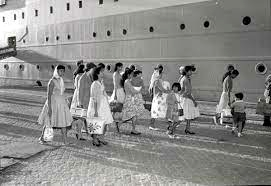
The arrival of Goans in Lisbon in December 1961.
Photo Credits: J Filipe Monteiro
In order to understand how the Goans ended up as immigrants in Germany, I will have to go back into history, with the Liberation of Goa in 1961 and the sequence of events that followed.
Following the Liberation of Goa, the Portuguese government had an open-door policy that facilitated Goans to immigrate to Portugal. All that Goans needed to do was to apply for Portuguese Passports through the Brazilian Embassy, which was in charge of Portuguese interest in India, with proof that they are of Goan origin. No other colony was afforded this facility by the Portuguese government.
After obtaining passports, Goans then had to find their way to the transit point in Karachi-Pakistan. They were adequately provided with lodging facilities until they were intermittently airlifted to their final destination in Lisbon with all their belongings, including grinding stones carried by some for their beloved spicy curry preparations.
Most Goans who ventured to leave Goa were mostly young men and women, but some entire families also uprooted themselves as dislocated persons to Lisbon. Not all Goans who migrated to Portugal, however, came directly from Goa. Some Goans from outside Goa, mainly from Mumbai and Karachi, also joined the bandwagon.
Upon their arrival in Lisbon, they were provided with full boarding and lodging facilities at Cordoaria, Rua da Junqueira 59 home for the deslocados do Estado da India. Here, the Goans were treated with respect and dignity by the Portuguese government and the people. Notwithstanding the dilemma for the Portuguese government, was what to be done with these dislocated persons from Goa? Some Portuguese-educated Goans were absorbed into the public administration. Some were enlisted in the mandatory three-year military service as independence movements were flaring up in African colonies, mainly in Angola, Mozambique and Guinea-Bissau.
The third group of Goans, who were mostly the non-Portuguese educated, were lagging behind without occupation. Few English-speaking Goans found jobs with the American company constructing the longest bridge of Europe at that time: the Ponte Salazar which was renamed Ponte 25 de April after the military coup (Revolucao dos Cravos) in 1974. Their turn of good fortune for the remaining Goans came in 1963, when Germany began recruiting workers from Portugal.
(The writer was a Senior NATO project manager for Europe District US Army Corps of Engineers in Frankfurt and was one of the early Goan settlers in Germany)